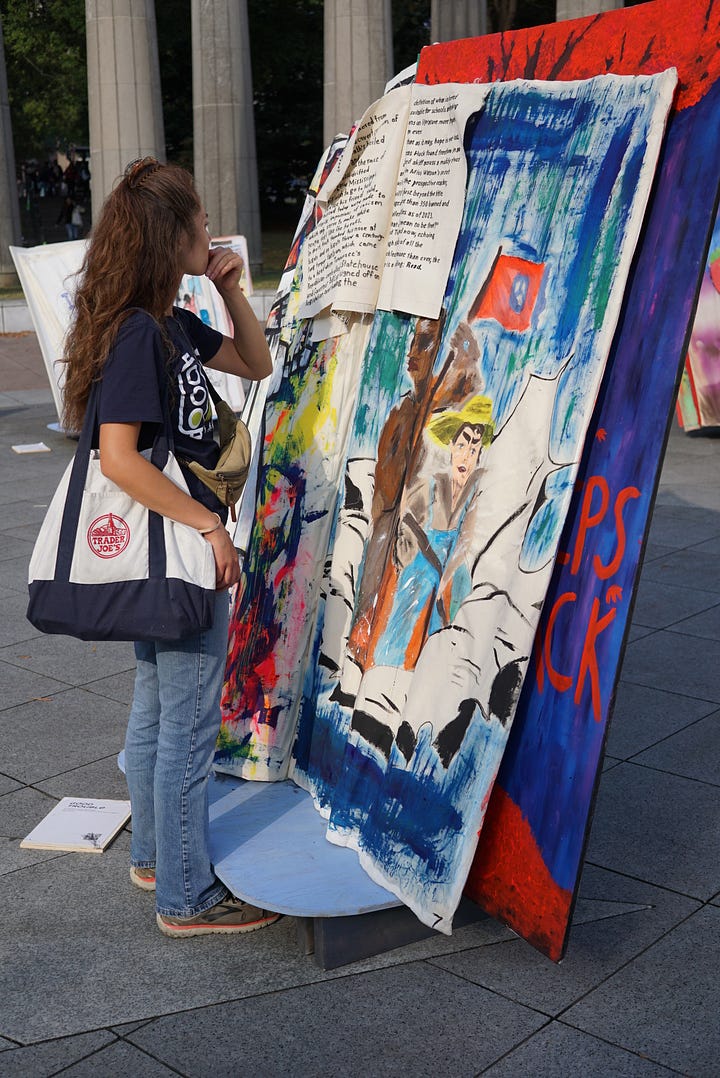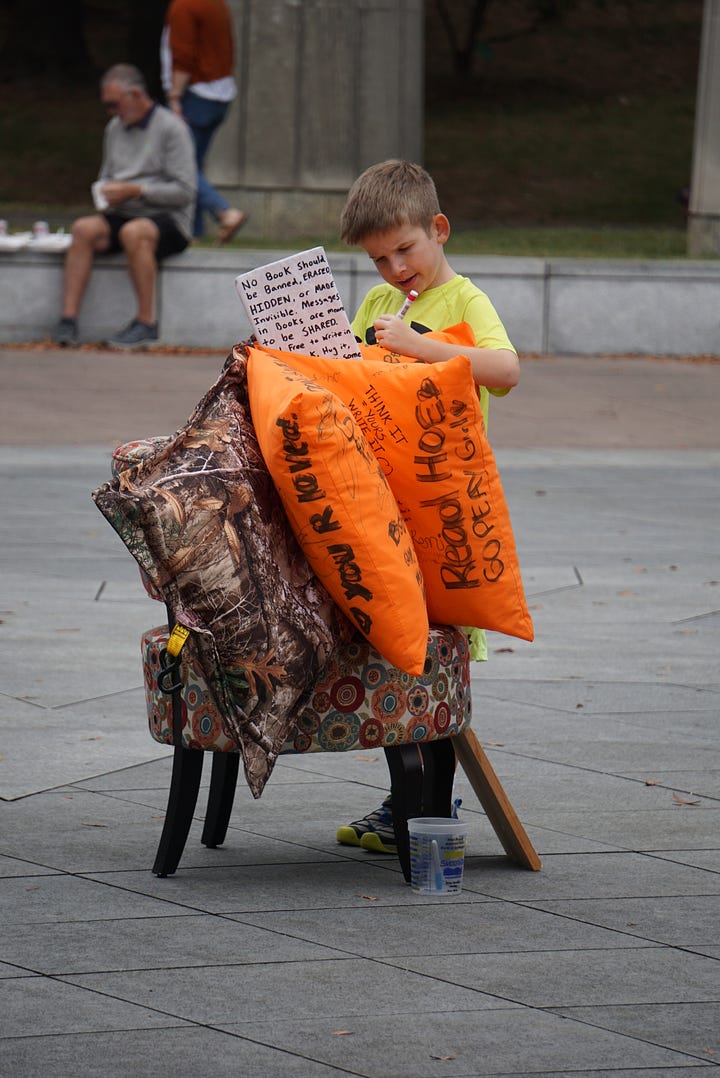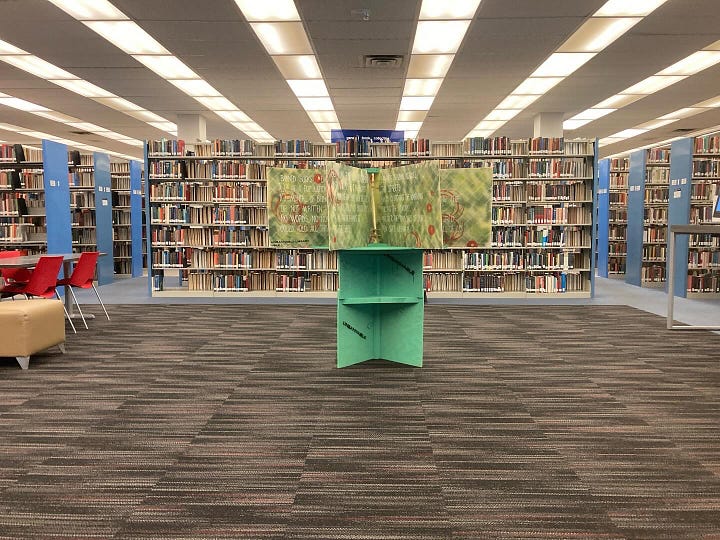Unbannable
A conversation about giant, undeniable books, art-making, and stories with Paul Collins.
Earlier this fall, in the aftermath of a restrictive new state school library law, a traveling exhibition across Middle Tennessee showcased a powerful demonstration of intellectual freedom and self-determination: the Unbannable Library. The oversized volumes – and the voices they contain – conceived and curated by artist and educator Paul Collins will not be denied or hidden. Read all about this project and explore the Unbannable Library catalog.
I spoke with Paul about this project to learn more about the library’s scale, the process of building a collection with a community of artists and writers, and the importance of creating an Unbannable Library right now. Excerpts from our conversation are below.
IArtLibraries: The books in the Unbannable Library are oversized/large-scale. Can you talk about what scale and size mean in the context of these works and the theme of "unbannable" books?
Paul Collins: I make artworks that are big books, so this library developed out of my personal practice. They’re six foot by four foot; when they’re open, they have an eight-foot span. The Unbannable Library is twenty-six volumes of these big books, each created by a different pair or group of artists and writers. They’ve been installed at libraries, art fairs, galleries, and most recently as a collection at the Southern Festival of Books during Banned Book Week.
There’s something very appealing about big books, just like it’s fun to work on a painting that’s a little bit bigger than you. It’s like being able to draw on the wall in a corner without getting into trouble.
The books in the Unbannable Library have been designed over time to feel like real books. The materials inside are light and durable; the giant pages flop and crinkle like regular book pages. Kids can literally disappear inside these books. The books’ size means that they are totally undeniable. They’re a power symbol for libraries – the libraries where they were exhibited didn’t want to let them go.




IArtLibraries: They even have their own book display stands.
Paul Collins: They do! The stands are modular, their design has also been refined over time.
IArtLibraries: This was a highly collaborative project about a very timely conversation happening at the local and national level. Can you tell us about the process of identifying and inviting artists and writers to participate as book creators?
Paul Collins: The idea is for a writer and an artist to make a big book together. When I started to put the word out about the concept and offered giant empty books, people jumped at the chance to make one. There’s a very real atmosphere of intimidation [related to book challenges in school libraries] in Middle Tennessee right now and a lot of people are affected: teachers, students, librarians, parents. A lot of self-censorship is happening. Each Unbannable Library book is based on or inspired by a banned or contested book or concepts related to censorship and true expression. These books, for the artists and writers and the libraries and communities that hosted them, are like anti-worry devices. Someone called them a love letter to libraries; lots of folks wanted to engage with that.




We were able to expand the tent of who considers themselves an art-maker. We had college-age artists and writers, retired artists or people who hadn’t made art in a long time, we had unhoused artists, youth artists, really a huge spectrum of people participated. This became an outlet for peoples’ energy.
IArtLibraries: Can you share a story or moment from the course of the exhibition that has stuck out to you or surprised you in some way?
Paul Collins: A couple come to mind. We connected with a high school teacher whose classroom functions as a “safe space” for kids between classes and over the lunch hour. He asked his students – not the kids he has in class, but the kids who come in to hang out – if they’d like to make a book. The kids jumped at the opportunity. They came in during their 15-minute breaks and over lunch time, ended up with ten students. One student created his own book based on Huck Finn and sewed it, embedded it into the giant book. One of my favorite mental images: the book was already assembled, so for two students to work on their pages at the same time, a third student had to stand and hold the middle pages with the two artists working on either side. That’s a true labor of love.
IArtLibraries: Do you have thoughts on the future of the Unbannable Library, and anything else you want to add today?
Paul Collins: I hope that the library continues to grow and evolve in where it happens and who contributes a book to it. I’d love to see it grow outside of Tennessee. I don’t know why there aren’t more big books in the world – they’re undeniable, you cannot deny or ignore or ban their contents. Book bans and challenges are responding to power, and these big books remind us of the true power of voices and stories. These books are not going to hide.
See all the Unbannable Library links at Paul’s linktree
Check out the Unbannable Library and his other works at Paul’s portfolio
For more information about nation-wide book bannings and challenges, go to the American Library Association website

